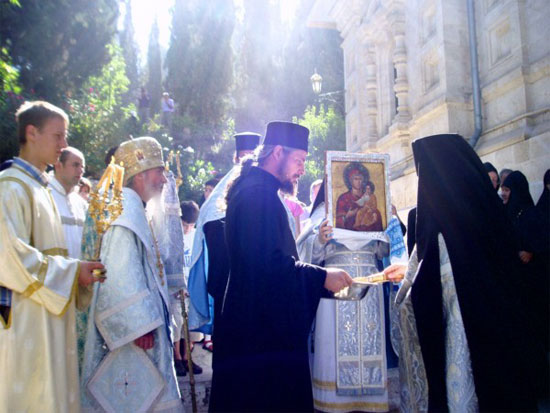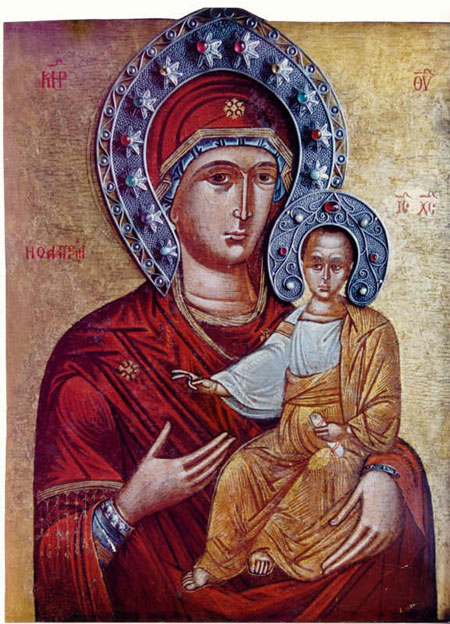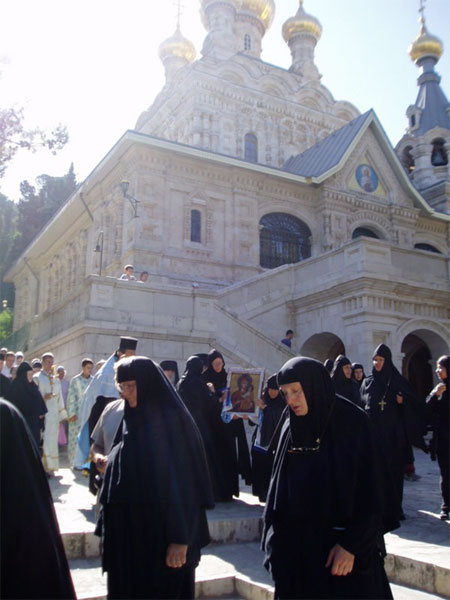NEWS
FROM THE DIOCESES |
| JERUSALEM: August 11, 2004 |
|
Celebrations at Gethsemane Convent August is the month of celebration for Gethsemane: August 4 (July 22), is the feast day of the Church of St Mary Magdalene, Equal-to-the-Apostles. This year, a group of pilgrims from Germany visited to share in this celebration, led by His Eminence Archbishop Mark of Berlin and Germany. Three years ago, Vladyka Mark worked on composing the service of St. Mary Magdalene. In the mineion is a simple service for this great pleaser-of-God, devoted disciple of Christ, "first to see the Divine Resurrection." Previously, we had to repeat the same sticheron over and over again. Through the labor of Vladyka Mark, the service is now adorned with many stichera, sedalens and troparia and is a worthy laudation of the holy Myrrh-bearer. The celebrations were solemn and quiet. Today was a true celebration—the day of the Hodigitria [Protectress], the Mother of God, whose miraculous icon is kept in our church. The Icon of the Hodigitria arrived in Gethsemane in the 16th century in miraculous fashion. In 1939, Metropolitan Elias of Lebanon had a vision from above: three times in his sleep he saw the Holy Great Martyrs Catherine and Barbara and imparted to him the will of the Queen of Heaven in regard to the icon of the Hodigitria, which Vladyka Elias kept in his cell. The Holy Martyrs said that this Icon was to be given to Abbess Maria in Palestine. Since the 16th century, the Icon was in the Lebanese town of Rihania and was glorified by many miracles: one time, a church burned to the ground, but the Holy Gifts and the Icon remained unharmed. The Icon was then given the title: "Unburning Bush." When a terrible plague struck Lebanon, believers turned to the Mother of God for help. Bishops and clergymen conducted processions of the cross through diseased neighborhoods, carrying the Icon of the Hodigitria, and where the procession past, the epidemic immediately ceased. Witnessing this miracle, the Church granted the Icon the additional name of "Healer." People began to gather in enormous masses to pray before it, receiving speedy help in accordance with their faith and prayers. And so the Icon was given a third honorific, "Speedy Intercessor." The Icon remained in Rihania and was greatly honored by the Orthodox populace. When Archbishop Elias was appointed Metropolitan of Lebanon, he traveled throughout his diocese, and of course stopped in Rihania. Metropolitan Elias especially revered the Most-Holy Mother of God. The name of Vladyka Elias (Karama) is closely bound with the salvation of Russia during the Second World War. When in 1941, Hitler neared Moscow and was already viewing the city through binoculars, Vladyka Elias went into seclusion for three days. Through fasting and weeping prayer, he asked for help for Russia, understanding that her salvation held the key to the fate of the whole world. It was revealed to him how Moscow could be saved from the fascists. He quickly sent a telegram to Stalin, in which he insisted that the Kremlin churches be opened, that a procession of the cross be made with the miracle-working Kazan Icon of the Mother of God. Stalin heeded the words of the bishop. Moscow was saved.
At the conclusion of the festal liturgy, Archbishop Mark of Berlin, Germany and Great Britain led a moleben and procession of the cross. So the residents of Rihania, seeing the piety of Vladyka before their Icon, decided to give it to him. Vladyka Elias was stunned and moved, seeing that they were prepared to part with their treasure. But they insisted, saying that this was the will of the Most-Pure Virgin herself, asking only that he not forget them in his prayers before it. Vladyka then accepted the Icon with great joy and gratitude. From then on he served a moleben and akathist before it every day. And so this miraculous, ancient Icon of the Most-Holy Mother of God willed that it be given to our convent, which had only begun its existence. The first superior of Gethsemane Convent was Abbess Maria, a Scot by birth. In 1936, she began the construction of Bethany School and at the same time began buildings in Gethsemane. Three years later, Mother Maria received a telegram with a plea to come to Beirut for the transfer of the holy Icon. The Icon arrived in Gethsemane two days before Lazarus Saturday, the feast day of Bethany, and immediately a series of miracles occurred. The first moleben was served by a priest, Fr. Seraphim. Lately the kind father had been asking everyone to pray for him to live to see the holy Resurrection of Christ. He was deathly ill and suffered a great deal from colon cancer. Suddenly, during a moleben, he turned and said aloud: "This icon works miracles; power is emanating from it, and I feel that I am no longer sick!" All the nuns began to cry. Fr. Seraphim lived another 10 years, during which time he did not cease serving.
The Gethsemane Hodigitria. The next day, entering the church, the nuns saw that the icon was "renewed," which until then had been dark, but now was bright and clean. On Lazarus Saturday, the Icon was taken to Bethany, where it was placed in the cave church. When this chapel was still being built, its central wall had a niche for an icon. It remained empty, since there was no icon for it, and Mother Maria would say: "Don't worry, the Most-Holy Mother of God will give us an icon Herself." The cave church was dedicated to the Mother of God. And so it was. On Lazarus Saturday, a great many people came to Bethany, among them a woman with a five-year-old boy who was completely paralyzed. Mother Maria said to her: "Come closer and kiss the icon. The Most-Holy Mother of God will help you." About two weeks later, the woman returned, leading her healthy son by the hand. She said that after earnest prayer, she anointed the boy with oil from the lampada which burned at the Icon. The next day, he felt better, and now was completely whole. The Hodigitria Icon was taken back to Gethsemane before Pascha. Here on the night of Passion Friday to Saturday, the Icon completely renewed its features and colors, and remains thus until today. Many other miracles are attributed to the Icon as well, too many to enumerate.
The nuns escort the miracle-working icon. According to tradition, on the feast day of the Hodigitria, after liturgy, we begin a procession of the cross around the entire monastery. The Icon is carried in turn by two nuns of the convent. Believers pass underneath the Icon. At the grave of Mother Maria, we pause for the reading of the Gospel. A group of German pilgrims once again prayed with us during this holiday. This year is the 65th anniversary of the arrival of the icon in Gethsemane. Vladyka Mark gave an insightful sermon on the Most-Holy Mother of God. During the great entrance, His Eminence Metropolitan Elias was commemorated. Eternal memory to him! The holiday was a true celebration. All sensed joy and spiritual uplifting. This we wished to share with you. Come to the Holy City of Jerusalem. Here among the great holy sites of Christianity, do not forget to visit the church of St. Mary Magdalene. On the right, in a carved wooden frame, you will see the wondrous icon of the Mother of God, the Hodigitria, the Unburning Bush, the Healer, the Speedy Intercessor. The Most-Holy Mother of God mercifully looks upon us from her icons and will soon hear the prayers of all who appeal to her with faith and love. Most-Holy Mother of God, save us!
Nun Amvrosia |


